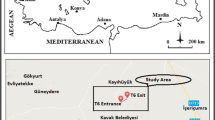Abstract
The documentation of excavation method and support design based on rock mass classification systems i.e. rock mass rating (RMR), Q-system and New Austrian tunneling method (NATM) for adit-7 tunnel being constructed in Garhwal Himalaya, India is discussed in this paper. The New Austrian tunneling method classes of rock units have been developed by using correlations with the RMR and Q systems, according to the ONORM B 2203. NATM principles were used because the geological conditions were continually changing. The study indicated that the RMR-based rock mass estimation was overstated, but the qualitative assessment was right. The NATM technique is more adaptable for Garhwal Himalayan rocks having various uncertainties in rock mass evaluation. The current adit investigations indicate that there are numerous unanswered concerns, concerning rock mass quality evaluation, tunnel behavior during construction and usability. Results of the analysis are considered to be useful for the design of the new tunnels constructed in the similar type of the terrain.
Similar content being viewed by others
References
Ahmad, T., Harris, N., Bickle, M., Chapman, H., Bunbury, J., and Prince, C. (2000) Isotopic constraints on the structural relationships between the lesser Himalayan series and the high Himalayan crystalline series, Garhwal Himalaya. Geol. Soc. Amer. Bull., v.112(3), pp.467–477.
Azad, M.A., Singh, S.K. and Nair, A.S. (2020) Application of Rock Mass Classification Systems for future excavation and support design of proposed Road Tunnel from Khand Birkot to Sarot Doman in Tehri Garhwal District, Uttarakhand. Himalayan Geol., v.41(2), pp.234–240.
Barton, N., Lien, R. and Lunde, J. (1974) Engineering classification of rock masses for the design of tunnel support. Rock Mech., v.6(4), pp.189–236.
Bieniawski, Z.T. (1989) Engineering rock mass classifications: a complete manual for engineers and geologists in mining, civil, and petroleum engineering. John Wiley & Sons.
Heim, A. and Gansser, A. (1939) The Throne of the Gods: An Account of the First Swiss Expedition to the Himalayas. Macmillan.
Hoek, E., Kaiser, P.K. and Bawden, W.F. (2000) Support of underground excavations in hard rock. CRC Press.
Gansser, A. (1964) Geology of the Himalayas. London, John Wiley & Sons, Ltd., 289p.
IS: 11315 (1987) Methods for quantitative description of discontinuities in rock mass — part 5, Bureau of Indian Standard, 9p.
Jain, A. K. (1971) Stratigraphy and tectonics of lesser Himalayan region of Uttarkashi, Garhwal Himalaya. Himalayan Geol., v.1, pp.25–58.
Kumar, G. (1975) Geology of the Srinagar-Nandprayag area (Alaknanda Valley), Chamoli, Garhwal and Tehri Garhwal districts, Kumaun Himalaya, Uttar Pradesh. Himalayan Geol., v.5, pp.29–59.
ONORM B 2203 after Oct. (1994) Austrian Standard Underground construction, Edition 10/1994
SEISAT (2000) Seismotectonic atlas of India and its environs. Geological Survey of India, India
Shekhar, S., Saklani, P.S. and Bhola, A.M. (2006) Geology and structure of Srinagar, Garhwal Himalaya. Himalaya (geological aspects), v.4, pp.153–169.
Singh, R., Umrao, R. K. and Singh, T.N. (2014) Stability evaluation of road-cut slopes in the Lesser Himalaya of Uttarakhand, India: conventional and numerical approaches. Bull. Engg. Geol. Environ., v.73(3), pp.845–857.
Singh, B. and Goel, R.K. (1999) Rock mass classification: a practical approach in civil engineering (Vol. 46). Elsevier, pp.62–78
Valdiya, K.S. (1980) Geology of Kumaun Lesser Himalaya. Wadia Institute of Himalayan Geology.
Valdiya, K.S. (1984) Evolution of the Himalaya. Tectonophysics, v.105(1–4), pp.229–248.
Acknowledgement
The authors wish to express their deep gratitude to the Indian RVNL Addl. General Manager Mr. Vijay Dangwal and site engineers Arun Gangwar and Vinod Kumar for their help and permission to write this paper. As this paper is a part of rail link between Rishikesh and Karanprayag (125km) Rail Vikas Nigam Limited (RVNL) project, we also sincerely acknowledge the M/s ITD Cem. India Ltd. for sharing the data. First author is grateful to Ph.D. advisor Prof. Shashank Shekhar, Dr. Vimal Singh for providing valuable suggestion and acknowledges the financial support in the form of fellowship from Department of Geology University of Delhi.
Author information
Authors and Affiliations
Corresponding authors
Rights and permissions
About this article
Cite this article
Azad, M.A., Naithani, A.K. & Singh, S.K. Application of the NATM Methodology for the Excavation of Rail Tunnel in Difficult Geological Conditions: A Case from Garhwal Himalaya, Uttarakhand. J Geol Soc India 98, 1553–1559 (2022). https://doi.org/10.1007/s12594-022-2211-y
Received:
Accepted:
Published:
Issue Date:
DOI: https://doi.org/10.1007/s12594-022-2211-y




